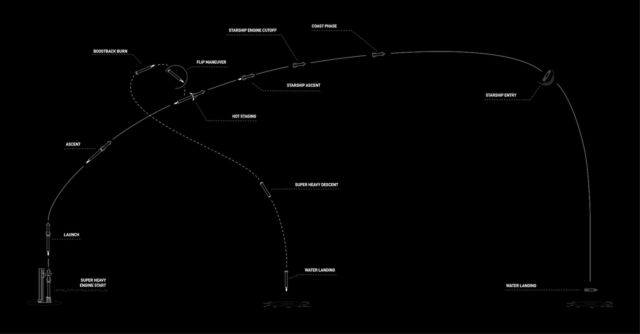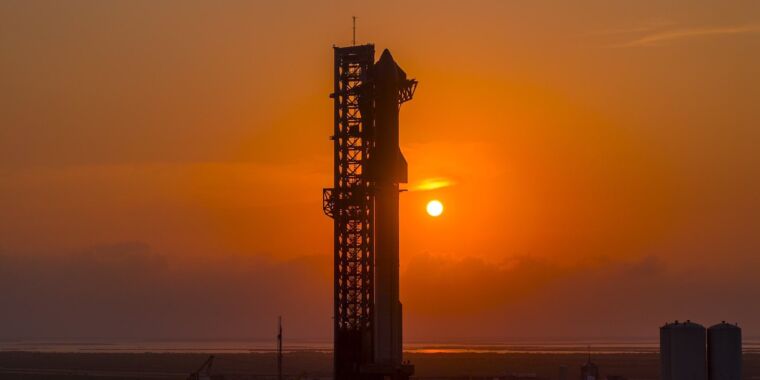SpaceX
The Federal Aviation Administration on Tuesday approved the commercial launch license for the fourth test flight of SpaceX’s Starship rocket, with the launch from South Texas scheduled for just after dawn on Thursday.
“The FAA has approved a license authorization for SpaceX Starship Flight 4,” the agency said in a statement. “SpaceX met all safety and other licensing requirements for this test flight.”
Shortly after the FAA announced the launch license, SpaceX confirmed plans to launch the fourth test flight of the world’s largest rocket on Thursday at 7 a.m. CDT (12:00 UTC). The launch window lasts two hours.
This flight follows three previous demonstration missions, each increasingly successful, of SpaceX’s privately developed mega-rocket. The last time Starship flew (on March 14), it completed an eight-and-a-half-minute ascent into space, but the ship couldn’t maneuver itself as it hovered nearly 155 miles above Earth. This controllability problem caused the rocket to fall apart during reentry.
On Thursday’s flight, SpaceX officials expect the takeoff portion of the test flight to be as successful as the March launch. The objectives this time will be to demonstrate Starship’s ability to survive the most extreme warming of the reentry, when temperatures peak at 2,600° Fahrenheit (1,430° Celsius) as the vehicle travels at more than twenty times the speed of sound collapses into the atmosphere.
SpaceX officials also hope the Super Heavy booster will guide itself to a soft landing in the Gulf of Mexico, just offshore of the company’s launch site, known as Starbase, in Cameron County, Texas.
“The fourth flight test shifts our focus from reaching orbit to demonstrating the ability to return and reuse Starship and Super Heavy,” SpaceX wrote in an overview of the mission.
Last month, SpaceX completed a “wet dress rehearsal” at Starbase, where the launch team fully loaded the rocket with cryogenic methane and liquid oxygen propellants. Before the practice countdown began, SpaceX tested the booster and ship at the launch site. More recently, technicians installed components of the missile’s self-destruct system, which would activate to blow up the missile if it flew off course.
Then on Tuesday, SpaceX lowered the spaceship’s upper stage from the top of the Super Heavy booster, presumably to put the finishing touches on the ship’s heat shield, consisting of 18,000 hexagonal ceramic tiles to protect the stainless steel structure during reentry . Ground teams were expected to bring the ship, or upper stage, back on top of the booster sometime Wednesday, bringing the rocket back to full altitude of 397 feet (121 meters) before Thursday morning’s launch window.
The ticking of Starship’s fourth flight
If all goes according to plan, SpaceX’s launch team will begin loading 10 million pounds of supercold propellants into the rocket on Thursday about 49 minutes before liftoff. The methane and liquid oxygen flow first to the smaller tanks on the ship and then to the larger tanks on the booster.
The rocket should be fully loaded about three minutes before launch, and after a series of automated checks, the computer controlling the countdown will command the booster’s 33 Raptor engines to ignite. Three seconds later, the rocket begins its vertical climb from the launch pad, with engines capable of producing more than 16 million pounds of thrust at full power.
From the Gulf Coast of Texas, the rocket will exceed the speed of sound in about a minute and then begin shutting down its 33 main engines about 2 minutes and 41 seconds after launch. Then, just as the Super Heavy booster jettisons to descend back to Earth, Starship’s six Raptor engines will ignite to continue pushing the rocket’s upper portion into space. The Starship’s engines are expected to burn to T+ 8 minutes and 23 seconds, accelerating the rocket to a near-orbital speed with enough energy to fly an arc-shaped trajectory halfway around the world to the Indian Ocean.
All of this will be similar to the events of the last Starship launch in March. What differs in the flight plan this time is the attempts to direct the booster and return it to Earth. This is important to lay the groundwork for future flights, when SpaceX wants to land the Super Heavy booster – the size of the fuselage of a Boeing 747 jumbo jet – on its launch pad. Eventually, SpaceX also plans to bring reusable spaceships back to Starbase or other spaceports.

SpaceX
Based on the results of the March test flight, SpaceX still has a lot to prove in these areas. During that flight, the Super Heavy booster engines could not complete all the burns needed to guide the rocket into the splashdown zone in the Gulf of Mexico. The booster lost control as it plunged toward the ocean.
Engineers located the fault in a filter where liquid oxygen flows into the Raptor engines. Notably, a similar problem occurred during the second Starship test flight last November. The Super Heavy booster launching Thursday will have additional hardware to improve propellant filtration capabilities, according to SpaceX. The company also made “operational changes” to the booster for the upcoming test flight, including jettisoning the Super Heavy’s collection ring, which sits between the booster and the ship during launch, to reduce the rocket’s mass during descent to decrease.
SpaceX has a lot of experience returning its fleet of Falcon 9 boosters. The company now boasts more than 240 successful rocket landings in a row, so it’s reasonable to expect SpaceX to overcome the challenge of recovering the larger Super Heavy booster.
